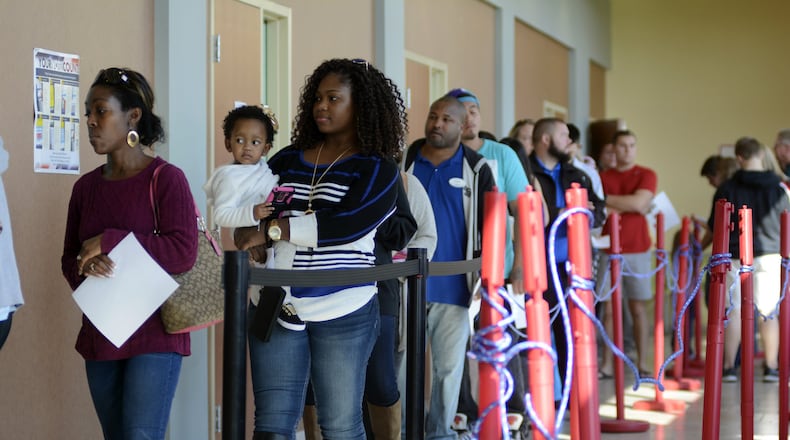Ohio, 38 other states and Washington, D.C., offer no-fault or no-excuse early voting at a centralized location. In Ohio, it’s at a county board of elections office. The Buckeye State is also one of 33 states, as well as the nation’s capital, to offer no-fault absentee voting, also known as vote-by-mail.
“Early voting is a very good thing because, in the end, it’s all about increasing access to the right to vote,” said Miami University Regionals political science professor John Forren, chair of the Department of Justice and Community Studies. “Over time, Ohio’s been a leader in this area in trying to figure out ways to make it easier to vote. If it’s easier for people to vote, it’s easier for people to participate in democracy, and that’s what it’s all about.”
OHIO NEWS: Public school leaders rally against private school voucher program
Many credited Ohio in the successful re-election campaign of President George W. Bush in 2004. Bush won the state by 2.1 percent, but issues with vote counts and voting machines led to Ohio's push to establish no-fault early voting.
Ohio lawmakers introduced bills to change voter access.
First, a bill established 35 days of early voting in Ohio. The first week of early voting was known as the Golden Week, during which Ohioans could register and cast ballots on the same day.
Nine years after establishing no-fault early voting, Ohio lawmakers in the Republican-led Statehouse voted to eliminate Golden Week. Democrats opposed the absence of funding to pay for the expanded responsibilities and the elimination of Golden Week.
Voting hours were first expanded, then reduced. Several organizations, led by the NAACP in Ohio, sued then-Ohio Secretary of State Jon Husted, and a settlement was reached in 2015 that included voting hours on the two Saturdays and immediate Sunday before Election Day.
For this primary election, early voting at county boards of elections runs from:
• 8 a.m. to 5 p.m. weekdays from now until March 6
• 8 a.m. to 7 p.m. from March 9 to 13
• 8 a.m. to 4 p.m. on March 7 and 14
• 1 to 5 p.m. on March 15 and 8 a.m. to 2 p.m. on March 16
Election Day is on March 17, and precincts in Ohio are open from 6:30 a.m. to 7 p.m.
OHIO NEWS: Ohio law would fine, suspend drivers for using cell phone and driving
Butler County GOP Executive Chairman Todd Hall agreed that early voting allows a variety of voting opportunities.
“Our local party has responded very well by encouraging and educating the electorate on early voting, and we also engage early voters with information on endorsed (Republican) candidates and issues,” he said. “The process has worked out well for voters and elections.”
Butler County Democratic Party Executive Chairman Brian Hester said the state has “started to fall behind other states” when it comes to early voting access. Ohio’s early voting lasts four weeks, and the national average is 19 days, according to the Ohio Secretary of State’s Office.
But Hester said Ohio could improve the process by allowing largely populated areas to have more than one early voting site during early voting, such as in Indiana.
“Often early vote sites aren’t convenient to college students and communities not near the location,” he said. “A voter in Indianapolis has five early vote locations. Our one location isn’t as convenient for voters in Oxford, or even Middletown, as it is for voters in Fairfield Twp.”
Butler and Warren counties have seen consistent growth in early voting numbers, closing in on 50 percent of the votes cast in presidential general elections, according to data from both elections offices.
Roughly 10 percent of the votes cast in Butler and Warren counties will be during early voting, officials said of their expectations. Both counties will see a strong increase in voter participation in November. Butler and Warren counties both could see more than 40 percent of the total votes cast in November coming before Election Day, according to historical data and trends.
But access to voting is “only one piece of the puzzle” to get more people participating in non-presidential general elections as voter turnout is often anemic in local-year elections, Forren said.
WHAT TO KNOW BEFORE YOU VOTE
• Early voting is at the board of elections office. The hours are: 8 a.m. to 5 p.m. weekdays from Feb. 19 to March 6; 8 a.m. to 4 p.m. on Saturday, March 7; 8 a.m. to 7 p.m. March 9 to March 13; 8 a.m. to 4 p.m. Saturday, March 14; 1 to 5 p.m. March 15; and 8 a.m. to 2 p.m. on March 16.
• All vote-by-mail ballots must be postmarked by Monday, March 16. You may have to ask your post office to postmark the envelope. You may hand-deliver your vote-by-mail ballot to the elections office any time until 7:30 p.m. on Election Day.
• Election Day is March 17, and polls are open from 6:30 a.m. to 7:30 p.m., and if you are in line when polls close you will be allowed to cast a ballot.
About the Author

